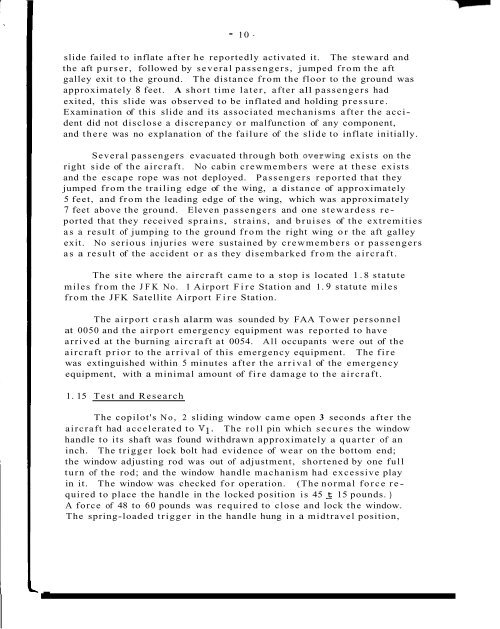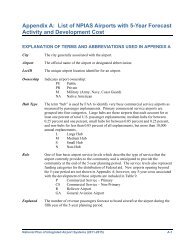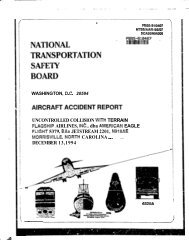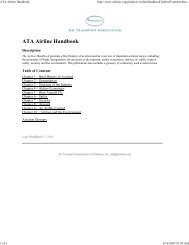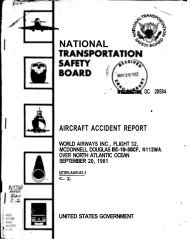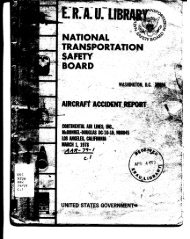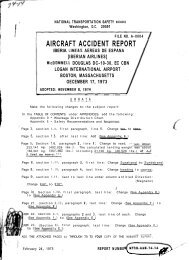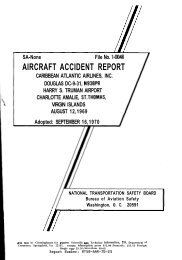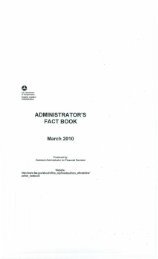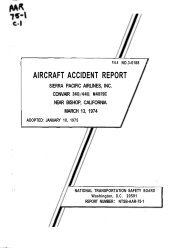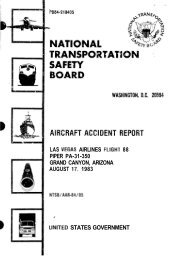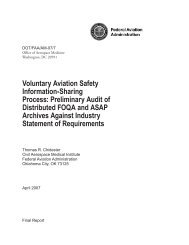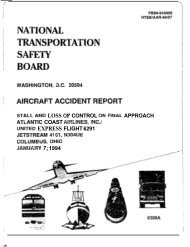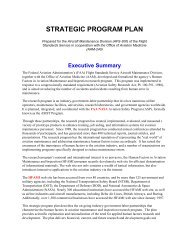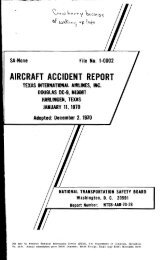NTSB/AAR-73-07 - AirDisaster.Com
NTSB/AAR-73-07 - AirDisaster.Com
NTSB/AAR-73-07 - AirDisaster.Com
You also want an ePaper? Increase the reach of your titles
YUMPU automatically turns print PDFs into web optimized ePapers that Google loves.
.<br />
- 10 -<br />
slide failed to inflate after he reportedly activated it. The steward and<br />
the aft purser, followed by several passengers, jumped from the aft<br />
galley exit to the ground. The distance from the floor to the ground was<br />
approximately 8 feet. A short time later, after all passengers had<br />
exited, this slide was observed to be inflated and holding pressure.<br />
Examination of this slide and its associated mechanisms after the acci-<br />
dent did not disclose a discrepancy or malfunction of any component,<br />
and there was no explanation of the failure of the slide to inflate initially.<br />
Several passengers evacuated through both overwing exists on the<br />
right side of the aircraft. No cabin crewmembers were at these exists<br />
and the escape rope was not deployed. Passengers reported that they<br />
jumped from the trailing edge of the wing, a distance of approximately<br />
5 feet, and from the leading edge of the wing, which was approximately<br />
7 feet above the ground. Eleven passengers and one stewardess re-<br />
ported that they received sprains, strains, and bruises of the extremities<br />
as a result of jumping to the ground from the right wing or the aft galley<br />
exit. No serious injuries were sustained by crewmembers or passengers<br />
as a result of the accident or as they disembarked from the aircraft.<br />
The site where the aircraft came to a stop is located 1.8 statute<br />
miles from the JFK No. 1 Airport Fire Station and 1. 9 statute miles<br />
from the JFK Satellite Airport Fire Station.<br />
The airport crash alarm was sounded by FAA Tower personnel<br />
at 0050 and the airport emergency equipment was reported to have<br />
arrived at the burning aircraft at 0054. All occupants were out of the<br />
aircraft prior to the arrival of this emergency equipment. The fire<br />
was extinguished within 5 minutes after the arrival of the emergency<br />
equipment, with a minimal amount of fire damage to the aircraft.<br />
1. 15 Test and Research<br />
The copilot's No, 2 sliding window came open 3 seconds after the<br />
aircraft had accelerated to VI. The roll pin which secures the window<br />
handle to its shaft was found withdrawn approximately a quarter of an<br />
inch. The trigger lock bolt had evidence of wear on the bottom end;<br />
the window adjusting rod was out of adjustment, shortened by one full<br />
turn of the rod; and the window handle machanism had excessive play<br />
in it. The window was checked for operation. (The normal force re-<br />
quired to place the handle in the locked position is 45 t 15 pounds. )<br />
A force of 48 to 60 pounds was required to close and lock the window.<br />
The spring-loaded trigger in the handle hung in a midtravel position,<br />
-


